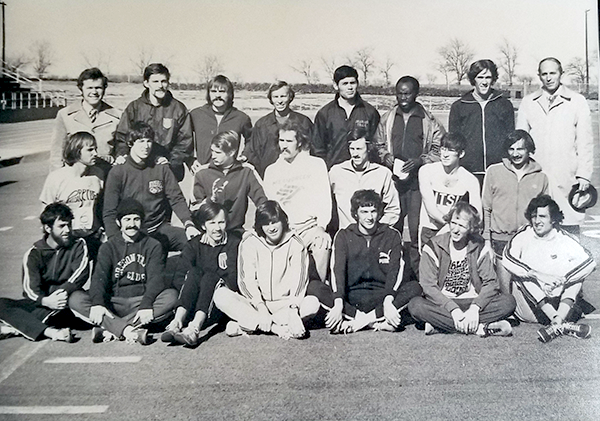This is the second in a series of articles on the Munich Olympics, which happened fifty years ago this week. This piece, by Jeff Benjamin, tells the story of Frank Shorter’s two ARs at the 10,000m in Munich, prior to his Olympic marathon win!
The Munich Olympics at 50! Second In A Series – August 31st & September 3rd, 1972-
Frank Shorter’s Magnificent 10,000s – 2 Of Them!
Updated 12 September 2022
On September 10th, 1972, American Frank Shorter would win the Olympic Marathon in Munich. That seismic event is remembered by many both inside and outside the world of Sport. Lost in the shuffle, however, are Shorter‘s other 1972 Olympic accomplishments, which took place a week earlier at Munich, feats which are still looked on in awe by aficionados who truly wonder what American runners could accomplish today! At the Eugene Olympic Trials, Shorter qualified for not only the Marathon but also for the 10,000 meters, running a series of 3 distance races in a short span. Now the self-coached Yale grad would attempt it again literally 2 months later! “My reasoning was to repeat what I had done in Eugene at the Olympic Trials,” said Shorter simply yesterday. “The schedule in Munich was the same, and it never occurred to me that I might not recover from the trial 10k over the weekend.” “Since I was self-coached, I didn’t need to debate my decision….it was a pattern for me.” Included in that decision were key workouts Shorter had done during the Spring leading up to the Trials and The Games. “I had done interval work but emphasizing surges,” said Shorter. “For example, if I ran 2:05 800 meters, I’d run 30 (first 200), 65 (mid 400), and 30 (final 200).” “In Oslo three weeks before, I ran 4×800 meters in 2:00 with a short recovery jog, and the overall effort was about 80% of max,” said Shorter, who had no doubts at all about his Postrace 10K recovery leading to the 26.2 milers a week later. “I believed an all-out effort in the final would not impact my marathon run…again, I felt fully recovered in Eugene,” said Shorter. “I always believed that resting too much might possibly disrupt one’s normal physical, dietary and mental build-up, and In a way, it was, as one from Texas might say, a “dance with who bring ya” situation – Don’t try anything new…I always followed a pattern for me.” On August 31st, Shorter toed the line in the 10K qualifier. “I just went along to qualify for the final,” said Shorter. “I knew I wasn’t the fastest sprinter, and I was counting heads and wanted to show the other competitors that I was there.” As he crossed the line in 3rd place (behind Tunisia’s Mohammed Gamoudi – 27:54.69 and Spain’s Mariano Haro – 27:55.89), Shorter saw his time flash across the scoreboard and became the first American to break 28 minutes in an American record time of 27 minutes, 58.23 seconds. “Wow!” Shorter recollected. “I saw I was under 28 minutes, and I’m thinking that I’m in pretty good shape!”
But the unexpected happened.
Like the rest of the Olympians, Shorter had to contend with the traumatic and tragic murders of Israeli athletes by Palestinian Terrorists at the Games, which delayed Olympic events by one day alongside calls for cancellation.
Shorter, who, like others, weighed the points of continuing to compete, summed it up best in a 2006 interview:
“We (the Athletes) forged our collective resolve. The Games were going to go on. We felt the Israeli athletes would have wanted this. I had a vague feeling that if, as a team, we did not try to win our remaining events, the terrorists would somehow win instead.”
So it was on to the 10,000 Final, which would turn out better than the qualifier, but also not without challenges seen and unseen.
Shorter had experienced these challenges on the track before.
“In 1971, I had been in races where a competitor would sometimes go out of their lane and elbow you,” said Shorter. “Basically, you wanted to stay away from them.”
In Munich, some of those competitors were racing Shorter again, but it would not be elbows that became the threat.
“Someone’s feet touched my calves behind me,” said Shorter, noting it was just the closeness of competitors trying to stay inside on Lane 1. “So I moved to the right to get out of the way.”
In the 12th lap, Shorter didn’t fall, but Finn Lasse Viren, in front of Shorter in 5th, Viren – then in fifth place – seemed to catch the heels of Belgium’s Emiel Puttemans and ended up sprawled on the grass on the inside of the track with Gammoudi as well. Somehow though, in the blink of an eye, Viren was back on his feet and chasing the race leaders from 30 meters behind, where he would rejoin the pack. Gammoudi would drop out.
“I was aware of the fall,” said Shorter. “But I was in the zone, and my instincts had taken over.
Shorter’s instincts and focus on the competition in the final were such that he did t pay attention to any split times. “We were just running and being competitive,” said Shorter.
“It was an all-out effort!”
Viren (who recently had a chair named for him! Link – https://www.core77.com/posts/112488/The-Self-Rising-Virén-Chair !) would dramatically go on to win the Gold in a World Record time of 27:38.35, with Shorter finishing in a 5th, clocking 27:51.32, breaking his 2-day old American record!
“I remember with a couple of laps to go that I could break 28 minutes again,” recalled Shorter. “But I wasn’t sure by how much.”
“Coming into the last lap, Viren was in the lead, and I just felt that I’m not going to fall back and try to finish as best as I could.”
“There was no disappointment in 5th place,” said Shorter. “I knew I wasn’t the fastest in the field, but I felt my performance was good.”
Those performances solidified Shorter’s belief in the upcoming marathon.
“No one in the marathon field had broken 28 for the 10K,” said Shorter, also noting his own reliance of keeping his legs sharp aside from endurance through speed work.”
“I felt I was ready.”
Frank Shorter sure was!
To see the last 300m of the Munich 10,000m, take a look here:
Author

Jeff Benjamin has written for 30 years for American Track and Field along with RunBlogRun. The Former President of the Staten Island AC & Chair of the Staten Island Running Association was the 5th man scorer for his Susan Wagner High School NYC XC City Championship team. Also a member of the College of Staten Island Sports Hall of Fame for XC, Jeff currently serves as the LDR Chairman for USATF NY. A passionate (or fanatical) follower of the Sport, some of Jeff's subjects have included Sebastian Coe, Emma Coburn, Eamonn Coghlan, Matt Centrowitz, Jim Spivey, Galen Rupp, Joe Newton, Tom Fleming, Ajee’ Wilson, Bill Rodgers, Allan Webb, Abel Kiviat, Jordan Hassay, Marty Liquori, Caster Semenya, Rod Dixon, Carl Lewis and Jim Ryun as well as Book Reviews and articles covering meets and races in the Northeast U.S.
View all posts






















